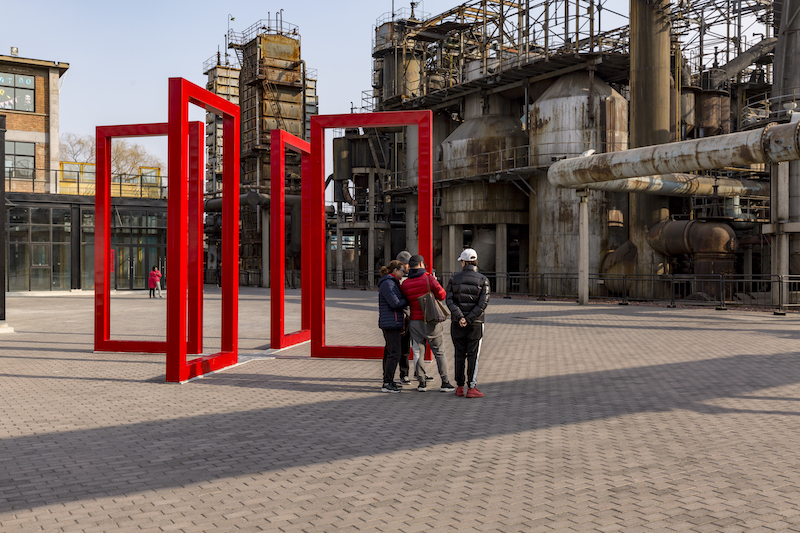In preparation for hosting the Summer Olympics in Beijing in 2008, the Chinese government had a slew of mega redevelopment projects in the works. One of these, dating back to 2004, called for tearing down a decommissioned, 1950s-era weapons factory to make way for new vertical construction that the city desperately needed.
But since the late 1990s, that 148-acre area, located in the northeast corner of Beijing, had emerged slowly but steadily as an artists’ enclave. And the uproar that ensued over the plan to demolish the buildings on that site led to an unexpected shift toward preservation that, a decade later, continues to pay dividends for this city, and is still evolving.
At the time when the Chinese government was considering demolition, “there wasn’t a lot of reverence for historical buildings,” recalls Michael Grove, a principal with Sasaki, the Boston-based design firm that developed the master plan for this site.
The outcry against razing the buildings, coming from local artists and cultural groups, struck a chord. But any alternative plan still needed to produce a steady revenue stream, provide a destination for China’s arts community, and preserve the area’s character.
SevenStar Group, a government-led consortium that owns the area’s land and manages the factory workers’ pension fund, joined forces with Baron Guy Ullens—a Belgian businessman, philanthropist, and art collector, who opened the first privately owned contemporary arts center in China—to commission Sasaki to come up with a vision for converting this area into an arts district.
“Ullens was taking a huge risk” opening his gallery, says Dennis Pieprz, a Sasaki principal. But while Ullens’ initial lease was for only seven years, “he was thinking well beyond that.”
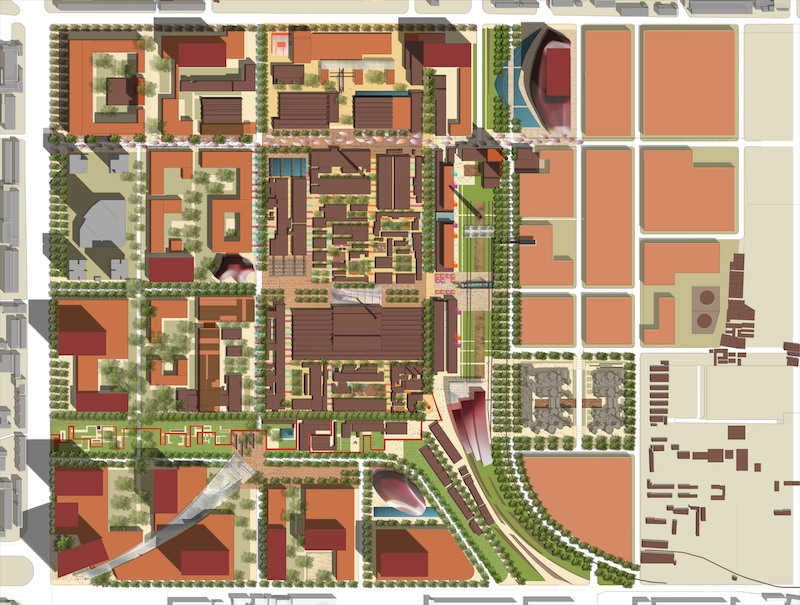
The 798 Arts Zone is wedged into 148 acres on the northeast corner of Beijing, where artists and creative tenants started gravitating to in the late 1990s. Image: Sasaki
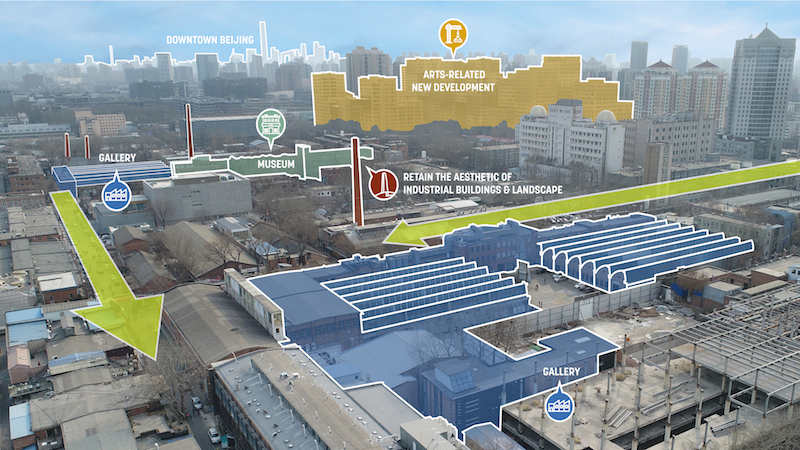
Sasaki's master plan called for preserving many of the factory's buildings for exhibit and event space, and retaining the area's industrial landscape. The presumption was that this redevelopment would lead to new construction around the zone's periphery. Image: Sasaki
Sasaki was “captivated” by the factory district’s architecture and infrastructure, which resembled the Bauhaus style. The firm worked with Urbis Development (an entity owned by Ullens) to catalog the existing buildings and identify those that would remain, “which was a lot,” says Pieprz. The plan would also suggest the development and installation of key cultural structures.
The 798 Arts Zone was born, named after the number on the building that was the first into which artists had migrated. Sasaki’s master plan strengthened the district’s connections with nearby transit stations, and established the guidelines for the buildings’ adaptive reuse.
The district’s factory buildings became museums (including the Ullens Center for Contemporary Arts), galleries, restaurants, and shops. The outside space around the buildings became settings for sculptures, as well as fashion and culture events. By January 2008, more than 400 cultural organizations from several countries had settled into this arts zone, according to contemporaneous news reports.
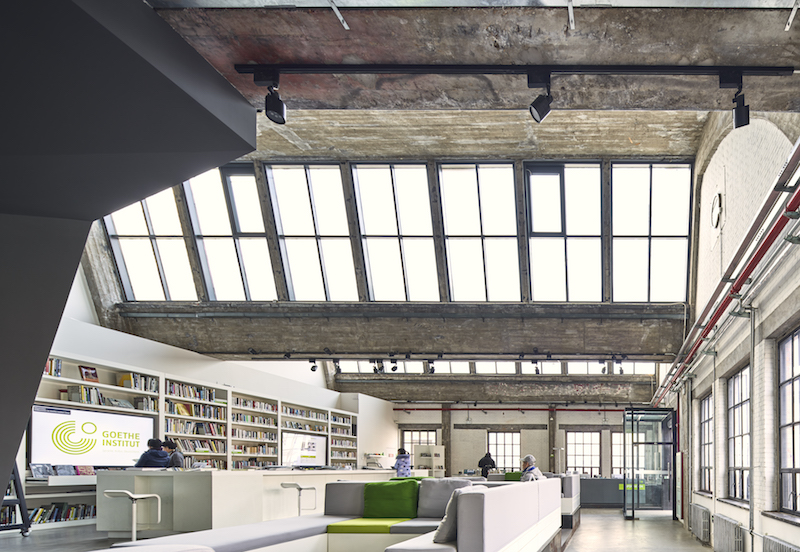
In 2015, the Goethe Institut China opened a new center in Beijing's 798 Art Zone. The event space is used for cultural and artistic exchanges, strengthening cultural ties between China and Germany. Image: Sasaki
The 798 Arts Zone is China’s third most-popular attraction, along with the Great Wall and the Forbidden City, with more than 3 million visitors annually. It was the recent recipient of the 2018 Pierre L’Enfant International Planning Excellence Award. SevenStar still features the arts district on its website, says Grove.
“It’s not static, and has evolved over time. Our plan was meant to be flexible, to allow for creativity.” Both he and Pieprz, though, are surprised at how closely 798’s development has followed Sasaki’s plan, especially since “we didn’t have a lot of interaction with the landowner,” says Grove.
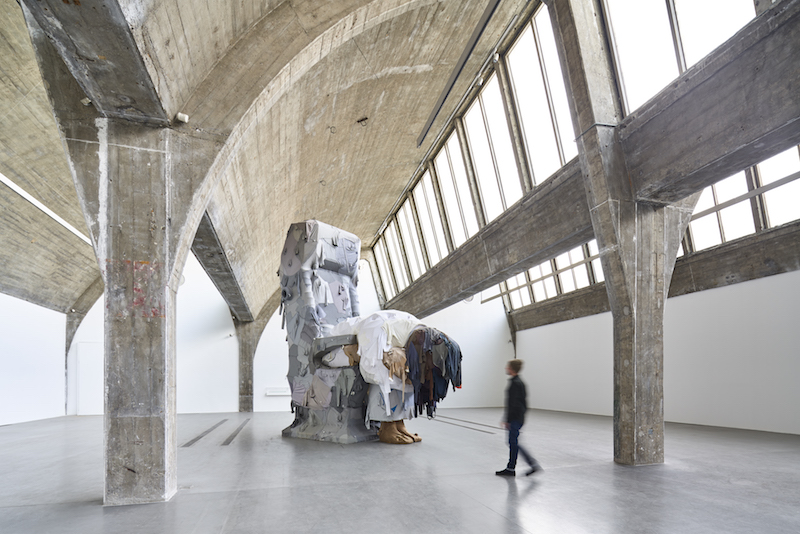
One of the striking art pieces on exhibit inside a converted factory at 798 Art Zone in Beijing. Image: Sasaki
New twists, possible additions
For the first time in several years, Grove returned to the district last February, and saw a number of new things:
•All of the plaza and public spaces that Sasaki inserted in its master plan “had been implemented”;
•There’s a ring of new development around the district, primarily low- and mid-rise office space for creative tenants such as ad agencies, media, fashion and software designers, and artists. “We wanted to avoid a sea of residential and office towers,” says Pieprz about what the master plan called for;
•One completely new building within the district is Audi’s Research & Development Center, which opened Feb. 1, 2013 inside the Audi China’s Building at 751-D Park. The 86,111-sf, six-story building has more than 300 employees and houses Audi’s labs and workshops for the Asia market. When it opened, this was Audi’s biggest overseas investment. “This building expands the district’s definition of art,” says Grove;
•An elevated walkway now meanders through the district. Grove says Sasaki’s master plan had called for a series of walkways, but the elevation surprised him. He speculates that this choice might relate to the success of New York City’s High Line.
798 Arts Zone still has a bohemian feel to it, and hosts myriad cultural events. The zone is the permanent home to the annual Beijing Queer Film Festival, despite China’s strict censorship laws. The international museum operator Pace has exhibit space in the district.
There’s always the fear, as with any popular venue, that 798 Arts Zone is becoming commercialized, gentrified, and high priced, especially when corporations like Audi, Uber, Volkswagon, and Canon have opened offices within its proximity.
But Grove and Pieprz agree that this kind of project, where incremental transformation occurs, is still rare. “Most projects are driven by scale, which is especially true in China,” says Pieprz.
The Sasaki execs also suggest that more changes could be in the offing. The firm’s master plan called for the eventual opening of a significant art school within the district. (Currently, there’s a small art school run by a Japanese tenant.) The plan also included a major performing arts center, and a railway that would run through a nearby park to the district. (The park, says Grove, has yet to be developed.)
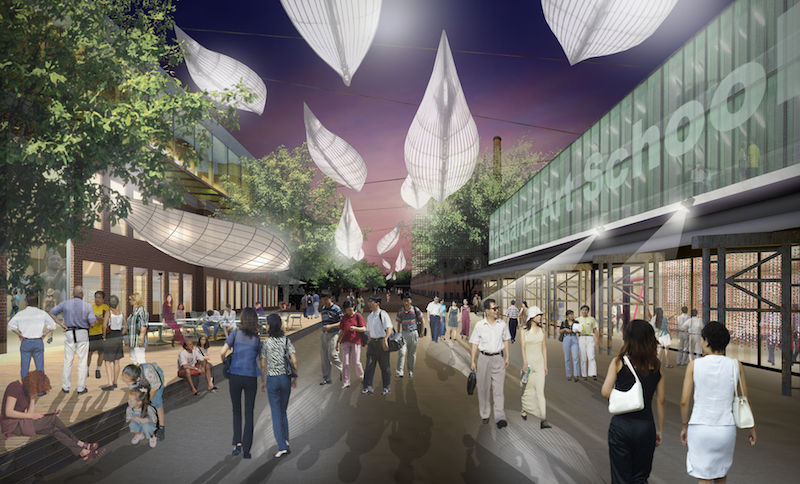
Sasaki's master plan envisioned the inclusion of a “significant” art school. Image: Sasaki
When Grove was in the district last February, a design director for 751, one of the converted factory buildings, approached him about pursuing future development.
“Our master plan was a strategy to create value,” says Pieprz, to which Grove adds “it’s an example of a flexible framework versus a mega project.”
Related Stories
Adaptive Reuse | Jan 18, 2024
Coca-Cola packaging warehouse transformed into mixed-use complex
The 250,000-sf structure is located along a now defunct railroad line that forms the footprint for the city’s multi-phase Beltline pedestrian/bike path that will eventually loop around the city.
Adaptive Reuse | Jan 12, 2024
Office-to-residential conversions put pressure on curbside management and parking
With many office and commercial buildings being converted to residential use, two important issues—curbside management and parking—are sometimes not given their due attention. Cities need to assess how vehicle storage, bike and bus lanes, and drop-off zones in front of buildings may need to change because of office-to-residential conversions.
K-12 Schools | Jan 8, 2024
Video: Learn how DLR Group converted two big-box stores into an early education center
Learn how the North Kansas City (Mo.) School District and DLR Group adapted two big-box stores into a 115,000-sf early education center offering services for children with special needs.
Affordable Housing | Dec 14, 2023
What's next for affordable housing in 2024?
As 2023 draws to a close, GBBN’s Mary Jo Minerich and Amanda Markovic, AIA sat down to talk about the future. What’s next in terms of trends, technology, and construction of affordable housing?
MFPRO+ News | Nov 21, 2023
Underused strip malls offer great potential for conversions to residential use
Replacing moribund strip malls with multifamily housing could make a notable dent in the housing shortage and revitalize under-used properties across the country, according to a report from housing nonprofit Enterprise Community Partners.
Office Buildings | Nov 10, 2023
3 important early considerations for office-to-residential conversions
Scott Campagna, PE, Senior Director of Housing, IMEG Corp, shares insights from experts on office-to-residential conversion issues that may be mitigated when dealt with early.
Adaptive Reuse | Nov 1, 2023
Biden Administration reveals plan to spur more office-to-residential conversions
The Biden Administration recently announced plans to encourage more office buildings to be converted to residential use. The plan includes using federal money to lend to developers for conversion projects and selling government property that is suitable for conversions.
Government Buildings | Oct 23, 2023
Former munitions plant reimagined as net-zero federal workplace
The General Services Administration (GSA) has embraced adaptive reuse with Building 48, an exciting workplace project that sets new precedents for how the federal government will approach sustainable design.
Esports Arenas | Oct 10, 2023
Modular esports arena attracts more than gamers
As the esports market continues to grow to unprecedented numbers, more facilities are being developed by universities and real estate firms each year.
Luxury Residential | Oct 2, 2023
Chicago's Belden-Stratford luxury apartments gets centennial facelift
The Belden-Stratford has reopened its doors following a renovation that blends the 100-year-old building’s original architecture with modern residences.


